Joel Kinnaman and Gary Oldman RoboCop
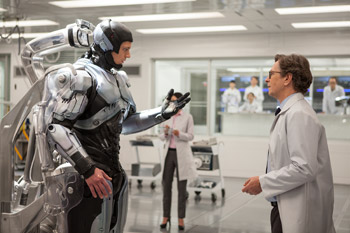
Joel Kinnaman and Gary Oldman RoboCop
Cast: Joel Kinnaman, Gary Oldman, Michael Keaton, Abbie Cornish, Jackie Earle Haley, Michael K. Williams, Jennifer Ehle, Jay Baruchel, Marianne Jean-Baptiste, Samuel L. Jackson
Director: José Padilha
Genre: Action, Sci-Fi
Rated:M
Running Time: 113 minutes
Synopsis: In RoboCop, the year is 2028 and multinational conglomerate OmniCorp is at the center of robot technology. Overseas, their drones have been used by the military for years, but have been forbidden for law enforcement in America. Now OmniCorp wants to bring their controversial technology to the home front, and they see a golden opportunity to do it. When Alex Murphy (Joel Kinnaman) – a loving husband, father and good cop doing his best to stem the tide of crime and corruption in Detroit – is critically injured, OmniCorp sees their chance to build a part-man, part-robot police officer. OmniCorp envisions a RoboCop in every city and even more billions for their shareholders, but they never counted on one thing: there is still a man inside the machine.
RoboCop
Release Date: February 6th, 2014
About The Film
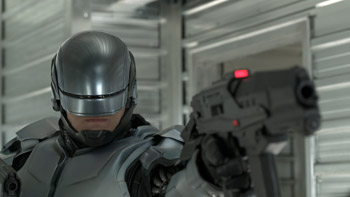 Man and machine unite in RoboCop, a reimagining of the 1980s cult classic, directed by José Padilha. In the film, Officer Alex Murphy becomes the star product of OmniCorp, the world's leading robotics defense company. In a Detroit ravaged by crime, OmniCorp sees an opening for the perfect policeman – a robot that can clean up the city, without putting police lives at risk. Trouble is, the idea of a robot pulling the trigger makes people anxious. To get it done, they compromise: after Murphy is mortally wounded, he wakes up in the hospital mostly a robot, barely a man at all – but all cop.
Man and machine unite in RoboCop, a reimagining of the 1980s cult classic, directed by José Padilha. In the film, Officer Alex Murphy becomes the star product of OmniCorp, the world's leading robotics defense company. In a Detroit ravaged by crime, OmniCorp sees an opening for the perfect policeman – a robot that can clean up the city, without putting police lives at risk. Trouble is, the idea of a robot pulling the trigger makes people anxious. To get it done, they compromise: after Murphy is mortally wounded, he wakes up in the hospital mostly a robot, barely a man at all – but all cop.
For OmniCorp, Alex Murphy represents a tremendous opportunity. 'He's a product they want to sell," José Padilha explains. 'He's a prototype. He's been developed, just like a soda company might develop a new bottle: they're trying to find the ideal design for a robot to sell to police departments. It's potentially billions of dollars for the company, so they're willing to cut a few ethical corners to get there. But they forgot something – inside the product, there is a man; it's not just a suit, it's a human being. They set up this invention that they think they can control, but they pick the wrong guy. They pick somebody too good, a guy determined to use his new powers for justice."
'OmniCorp's idea is that they need a man inside the machine, a man who makes the decisions so the corporation won't be held liable if something goes wrong," says Joel Kinnaman, star of the television series 'The Killing," who plays Alex Murphy. 'They leave his emotions intact in social situations, but when facing a threat or when a crime is committed, the computer takes over. When they realise his emotions make the system vulnerable, they completely shut them off. But when Alex comes in contact with his family, his emotions find a way back and override the computer system. He starts making his own decisions again."
Joel Kinnaman says he was attracted to play the role of Alex Murphy after meeting with José Padilha. 'José Padilha described his vision – his philosophical and political ideas that could fit inside the concept of RoboCop," says Joel Kinnaman. 'You could use that concept to talk about a lot of other interesting things. He wanted to make a fun action movie that discusses philosophical dilemmas that we will face in the very near future. And I wanted to be a part of that."
'Back in the 80s, the idea of a half-man, half-robot could only take place in the far future. But it's actually happening now," says José Padilha. 'From prosthetics to drones to self-driving cars, this idea is becoming part of everybody's life. It's raising a lot of legal and ethical issues that we're all dealing with. And Alex Murphy embodies all of those questions – what happens when you put the man inside the machine?"
José Padilha says that his involvement with the film began by a fortunate twist of fate: 'I had a meeting at MGM, and we were talking about movies I might want to make. They had a poster of the original RoboCop, and I said, well, that's the movie I want to make. I think it's a brilliant film, an iconic classic. I gave them my take, and they said, -Let's do it.' It was a lucky coincidence – a studio that had the right material, a guy who is a fan, and a poster."
The producers of the film, Marc Abraham and Eric Newman, say that José Padilha was the perfect choice to helm this new vision for RoboCop. 'The studio took a real chance," says Marc Abraham. 'They went to a filmmaker who had made some brilliant documentaries as well as two films, Elite Squad and Elite Squad 2, that became extraordinarily successful, particularly in Brazil – Elite Squad won the Golden Bear at the Berlin Film Festival. They were excited about hiring a filmmaker who was out of the box to make a movie that was out of the box."
'There's a frenetic quality to José Padilha's films," says Eric Newman. 'You come away from his movies thinking, -That's cool.' But at the same time, he invigorates the movie with a point of view." And, Eric Newman adds, RoboCop provides a great framework to do just that. 'RoboCop is just as relevant as when it came out," he continues. José Padilha wanted to make a movie that worked on two levels – it had to be action packed and have that -wow' factor with things no one has seen before – but also thematically relevant, with something to say about the world."
'I think it's fun to go to a movie, have a great time, and at the same time, come out thinking, -there's an issue here,'" he explains. Through his admiration for RoboCop, José Padilha saw a way to bring the story to the screen in a new and very contemporary way. 'The themes of the movie are even more current today," he says.
'We are getting close to a world in which warfare will be automated. We're going to have robots replacing soldiers and policemen. Right now, we're beginning an intense discussion about drones, which are not automated – there's a human being, observing from a remote location, deciding when to pull the trigger. But what happens when software, an algorithm, makes that decision? Everything in the movie is going to be in the real world very soon, and we're going to have discussions about whether this is OK or not. It's fascinating for me to have a chance to tackle this project years later, with the insight of all that has happened technologically, and try to recreate it in the current time for our current issues, but still keep the philosophical core of the original character."
The issues aren't just ethical or moral, but also practical. 'Let's say you buy a car that drives itself and the car loses control and runs over someone. Whose fault is that? Who gets sued? You, or the company that made the car?" asks José Padilha. 'Well, what if a cop makes a mistake and kills someone? Today, it's the cop that's to blame, not the police department. But what if the cop is a robot? All of these issues that come with technology can be discussed within RoboCop."
And it's not just political – it's also very personal for Alex Murphy. 'In the movie, people have to believe that the machine knows what it feels like to be human, so they keep Alex Murphy's brain intact. He has all his emotions. He has all his memories. He has cognitive capabilities. However, he can't hold his son or have sex with his wife," says José Padilha. 'It's a nightmare being Robocop. The movie is very much about the drama of this man facing the existential question – how am I going to go forward like this? Is Alex a machine or a human being?"
Even if the film has an existential element, there's still plenty of cool factor. For the filmmakers, dabbling in robot technology was like an open playground. 'One of the most exciting things to us – as filmmakers but also fans – was to create all the robots," says producer Eric Newman. 'We had a lot of fun with those. We have the ED-209s, the hyper-aggressive killing machines. We have the EM-208s, the humanoid-sized perfect soldiers."
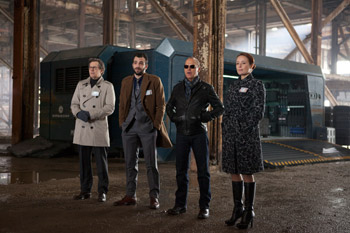 Production designer Martin Whist, who designed the various iterations of RoboCop as well as the ED-209 and EM-208, says that even as they let their imaginations run wild, the truth was right there to back them up. 'Every idea we had for something RoboCop could do, it turns out, somebody is researching it now, in real life," he says. 'For example, there are people out there right now in the lab, who have sensors on their brains that allow them to move a robotic hand with their thoughts. We had this idea for a high-powered Taser gun – and it turns out that it's being developed. Everything in the movie is based in reality."
Production designer Martin Whist, who designed the various iterations of RoboCop as well as the ED-209 and EM-208, says that even as they let their imaginations run wild, the truth was right there to back them up. 'Every idea we had for something RoboCop could do, it turns out, somebody is researching it now, in real life," he says. 'For example, there are people out there right now in the lab, who have sensors on their brains that allow them to move a robotic hand with their thoughts. We had this idea for a high-powered Taser gun – and it turns out that it's being developed. Everything in the movie is based in reality."
'It was imperative that the movie was grounded – it had to feel authentic and believable," says Eric Newman. 'One of José Padilha's great advantages is that he trained as a physicist, so his BS detector is very finely tuned. He questioned the scientific veracity of everything, and as a result, we have a movie that feels very legitimate."
RoboCop himself has two separate and very different suits in the film. 'The first suit was intentionally a tip of the hat to the original film and the original design," Whist explains. 'I wanted to stay with the coloration of the original design; the overall impression is silver, but – just like they did on the first film – we used a technique where there were multiple colors in it: there are magentas and deep blues in it. It's a little less sophisticated than the second suit, a little boxier, a little less agile, and that was intentional to show the evolution from one RoboCop to the next."
In the original RoboCop, the filmmakers used stop motion animation for the ED-209. For the new film, the filmmakers naturally chose visual effects. 'When you first see the ED-209 in the original film, it's such a memorable moment – but because of the type of animation, they were limited in the way they could move the camera or compose the shots," says Visual Effects Supervisor James E. Price. 'Now, we're able to use modern tools, and we have a lot more flexibility. We can really integrate sophisticated motion and composites into those scenes. And that's a perfect fit for José Padilha's filmmaking style – he's very active with the camera, very in the moment. We didn't have to lock down the camera, and we could let the visual effects play out the way he wanted to shoot it."
About The Characters
Joining Joel Kinnaman as Alex Murphy is an all-star cast, including Gary Oldman as Dr. Dennett Norton, head of the Omni Foundation, who creates RoboCop; Michael Keaton as Raymond Sellars, OmniCorp's CEO; Abbie Cornish as Alex Murphy's wife, Clara Murphy; Jackie Earle Haley as Mattox, who trains Murphy after his transformation; Michael K. Williams as Alex Murphy's partner, Officer Jack Lewis; Jennifer Ehle as Liz Kline, OmniCorp's Chief Legal Counsel; Jay Baruchel as Tom Pope, head of marketing for OmniCorp; Marianne Jean-Baptiste as Detroit Police Chief Karen Dean; and Samuel L. Jackson as Pat Novak, a television pundit.
Joel Kinnaman says he was excited to work with José Padilha. 'We're talking about a plausible future, but one that doesn't exist yet," says the actor. 'He makes it very believable – not too outrageous or farfetched. We're close to the world of this movie – we have bionic limbs, they're attempting fake hearts. It's still science fiction, but it's a realistic leap in the future."
Joel Kinnaman was especially interested in exploring the ways that Murphy regains his humanity after it is stripped away from him. 'Later in the film, Alex is supposed to have no emotions – Norton has reduced his dopamine levels to zero. But something compels him – he starts to search through all of the camera memories he has in his brain. He has access to all of the CCTV cameras in the entire city going back 20 years, and he starts searching for images of his son, his wife, himself, to remind him of who he is. And when he does that, his emotions start coming back. He goes back and recreates the assassination attempt on his life, he starts investigating his own murder. These components start bringing him back to life – it brings the humanity back inside of him. His family is the reason that he starts to regain his humanity."
Joel Kinnaman says that, like many actors, being in costume helped him to portray the role – even if this costume was by far a greater challenge than he'd ever faced before. 'The suit weighs about 45 pounds. It was constantly uncomfortable, constantly at the wrong temperature, either too hot or too cold. But that was very helpful. As awkward as I felt being in there, I realised that it paled in comparison to what Alex Murphy was feeling. I might have felt insecure and naked – because, weirdly, you don't wear clothes in the suit – but Alex would have felt 100 times that weirdness. It completely helped my character."
Despite the physical discomfort of the suit, Joel Kinnaman sought to express the way that RoboCop represents the cutting edge in robotics through his character's movements. Gone are the days of the clunky and jerky robotics. 'They are getting very good at making humanoid droids move very realistically – for example, in Japan, they have nursing droids with very soft movements that give comfort to old people," Joel Kinnaman notes. 'So the idea we had for RoboCop's movement was that it would be superhuman: everything would work exactly as it should on a human body. He walks perfectly, extremely fluid." Still, they couldn't resist making a small nod to the past. 'We also did want to make a small homage to the way Peter Weller moved – for example, when I was walking, I'd turn my head first and then the shoulders afterward."
Joel Kinnaman did extensive research before taking on the part. 'Alex Murphy is a seasoned SWAT cop – he knows his stuff. So I had to know my stuff, too, to make it look accurate," he says. 'I had to learn how to handle a gun better than I could before. For some of my previous projects, I had worked for a couple of days with Swedish special forces, so I continued working with them for another two weeks. I also worked with Uncle Scottie, who was an LA Metro cop for 25 years and 10 years in SWAT."
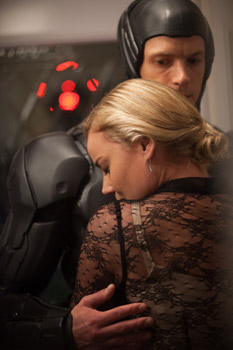 In many ways, the key relationship in the film is that between Alex Murphy and Dr. Norton, the scientist who creates RoboCop. 'The relationship between Alex and Dr. Norton is very complicated – in some ways, it's very much like Dr. Frankenstein and the monster," says Joel Kinnaman. 'There's trust – that trust is broken – and the trust is rebuilt. It almost becomes a strange father-son relationship."
In many ways, the key relationship in the film is that between Alex Murphy and Dr. Norton, the scientist who creates RoboCop. 'The relationship between Alex and Dr. Norton is very complicated – in some ways, it's very much like Dr. Frankenstein and the monster," says Joel Kinnaman. 'There's trust – that trust is broken – and the trust is rebuilt. It almost becomes a strange father-son relationship."
'Their relationship is complicated – it's like a father and son at times," says Oscar® nominee Gary Oldman, who plays Norton. 'Alex is an experiment that Norton becomes emotionally attached to. And for someone as obsessive as Norton, he's a challenge that can't be overlooked. Every parent has the moment when they prove to be a disappointment to their child – and that's what Alex experiences with Norton."
'Norton is a bionic engineer – a scientist, a brain surgeon on steroids," says Oldman. 'He's very clever, very smart – maybe too smart for his own good. He's pioneering technology for amputees and veterans – giving them a second chance, a new lease on life."
But his work takes a turn when he takes on his greatest challenge – Alex Murphy. 'He's under a lot of pressure to get RoboCop out on the streets – even though he might not be ready," says Gary Oldman. 'Norton is in a real pickle. He has to go against everything he believes in as a doctor – that's where all of the ethical and moral problems start."
Like Joel Kinnaman, Gary Oldman was persuaded to join the project when he heard Padilha's take on a new vision for RoboCop. 'José Padilha's work is both original and subversive," says Gary Oldman. 'For all intents and purposes, he's an indie filmmaker coming to pop culture – dipping his toe in that, and making it smart, too."
Michael Keaton plays Raymond Sellars, the CEO of OmniCorp. José Padilha says that though Raymond Sellars is ostensibly the film's villain, he wanted to portray a fully human character – one who is almost right. 'There's a very good case for using robots at war, or for law enforcement: robots are not corruptible, they don't get tired, they don't have prejudice, they're not racist," he explains. 'Raymond Sellars makes that case brilliantly. He's not the usual bad guy – he goes wrong, but he makes total sense."
'Raymond Sellars wants to be part of changing the world," notes Michael Keaton, 'so he becomes the linchpin in this whole conversation – the question of whether this use of this technology is correct or incorrect, moral or immoral. He's a bright guy who is extraordinarily ambitious, a big thinker, an amateur futurist but also very practical. He manipulates Norton, but not because he's evil or a liar – he has an agenda, and he tells Norton exactly what he wants done and how he wants Norton to do it. He's so convinced that he's right."
In playing the role, Michael Keaton went to the highest sources to get some background into the cutting edge of the technology. 'I learned a lot, because I had to know a lot about Sellars' world in order to be honest on screen," says Michael Keaton. 'I talked to some roboticists from MIT and a friend of mine who had written a book – a guy I've known 20 years. It's extraordinary what they're doing with robotics – how we're going to live. One of the men I spoke with was a mountain climber who years ago got lost in a snowdrift and lost his legs to frostbite; well, he still climbs and he helped create the technology that lets him do that. There's technology in which the brain sends a message to a nerve, and the nerve reacts as though a prosthetic leg were a real leg; I talked to a veteran who has one of these prostheses and he said he thinks about his prosthesis as being part of him. José Padilha is way deep into this stuff – these areas that have more questions than answers."
The role of Clara, Alex's wife, is played by Abbie Cornish. 'Clara's a very grounded, strong and intelligent woman – a loving wife and mother," says Abbie Cornish. 'Her family epitomizes a happy working middle class family, whose lives are then torn apart by the events that unfold in the film. However, the bond and connection between the Murphy's holds strong, and provides a very human and emotional through line to Alex's journey after he becomes RoboCop."
Abbie Cornish says that Clara is placed in the position of a particularly grim choice. 'Sellars and Norton are looking for the most likely candidate to be transformed into RoboCop, and when they select Alex, it's Clara who has to make the ultimate decision and sign the documentation," she explains. 'How do you make that choice? When you're told that your husband will die without it, but if he goes forward with the procedure he will change entirely? What would you do?"
Jackie Earle Haley, an Oscar® nominee for his role in Little Children, takes on the role of Mattox, an ex-military operative now working for OmniCorp, charged with making sure that all robotic technology passes military-level muster – and that includes RoboCop. 'He has a serious military background, but finds himself in a privatized world working for OmniCorp," Jackie Earle Haley explains. 'He's definitely a button-down guy, but he's also a little snarky, with an attitude. He really loves his robots – and in fact, he thinks of his robots as minimizing risk. He knows exactly what the robots are going to do. That's why he's got a problem with RoboCop – he thinks if you put organics into the system, it just increases the uncertainty and the risk."
Jackie Earle Haley says he has been training for this role for many years – in a manner of speaking. 'I moved to Texas about 13 years ago. With a friend there, I've been shooting different kinds of guns nearly that entire time," Jackie Earle Haley explains. 'We do it just for fun – we hunt a bit – but the main reason we do it is so I can apply that knowledge to my work. When I got on the set of RoboCop, I was able to ask questions about the specific weapons I'd be firing and how they might be similar to guns I'd already shot. That kind of background is incredibly useful."
my work. When I got on the set of RoboCop, I was able to ask questions about the specific weapons I'd be firing and how they might be similar to guns I'd already shot. That kind of background is incredibly useful."
Michael K. Williams, who brought to life the memorable character of Omar Little in the HBO series 'The Wire," joins the cast of RoboCop as Murphy's partner, Jack Lewis. Michael Williams says he was excited to be part of the cast – and physically acting opposite Joel Kinnaman was an unusual experience. Michael Williams' role was split into two: first, he shot his scenes with Joel Kinnaman before Murphy's transformation into RoboCop; then, a short while later, Michael Williams rejoined the production to shoot his scenes with Joel Kinnaman in the RoboCop suit. 'As we were wrapping one night, it struck me – this was the last time I would see Joel as Joel – as a human being. So I gave him a pound – see ya later. And sure enough, next time I saw him, he was RoboCop. I gave him a pound – it hit him on the shoulder and I almost broke my hand!"
Two-time Tony Award-winner Jennifer Ehle, who most recently co-starred opposite Jessica Chastain in the acclaimed film Zero Dark Thirty, plays Liz Kline, OmniCorp's corporate lawyer. She notes that in a story that is so much about the ethical and moral choices we all will face in the near future, her character is one whose worldview is not all that different from ours in the present. She says, 'Liz Kline is functioning in a world that is fully of technology, but the nuts and bolts of her work aren't that different than what a lawyer would be doing today. That's interesting – everyone else is pushing boundaries and creating new worlds, and she's dealing with the black-and-white of the law."
Jay Baruchel plays Tom Pope, the superficial head of marketing for OmniCorp – a man who sees RoboCop as much as a consumer product as a law enforcement tool protecting and serving the people of Detroit. 'Pope is a marketing guy, too slick for his own good," says Jay Baruchel.
It was important to Jay Baruchel and the filmmakers that the audience would immediately take in where the character was coming from – and much of that could come from Jay Baruchel's costume. 'The costume designer, April Ferry, decided that he would be something of a label hound," Jay Baruchel explains. 'So I've got her favorite wardrobe in the movie. Every day, I was dressed to the nines in super fashionable stuff – stuff that I normally wouldn't be caught dead in. But I know it looks nice, and I'm happy that my mother finally gets to see me dressed in a suit."
Marianne Jean-Baptiste takes on the role of Karen Dean, Detroit's chief of police. 'She's a very powerful go-getter," says the Oscar®-nominated actress. 'She's worked her way up the ranks in the police department. She wields a lot of power – and she enjoys doing that. But I think she's fair with her staff and she's well-respected."
Oscar® nominee Samuel L. Jackson rounds out the cast as Pat Novak, a political commentator. 'Sam Jackson described his character as Rush Sharpton!" laughs Joel Kinnaman. 'He's very opinionated, very pro-robotics and pro-OmniCorp."
'We got Samuel L. Jackson, who is a great actor – he has such a presence and charisma – but the thing that surprised me was how prepared he was," says José Padilha. 'We gave him these long monologues, so many lines, and he just nailed them, first take, no mistakes."
About The Design
To achieve the futuristic look of RoboCop, the filmmakers turned to production designer Martin Whist. Though a production designer's stock in trade are typically a film's sets – and indeed Whist was responsible for these – he also designed several other aspects of the film, including the RoboCop suits, the bikes and cars, the weapons, and the VFX robots: the ED-209 and EM-208. 'It's the first time I was involved with designing elements that would animate in the visual effects world," he explains. 'There were a lot of new challenges that were very engaging and I enjoyed a lot – from cars to bikes to suits to weapons. And that was all on top of the sets!"
Whist says that he was able to achieve such a wide scope of work on RoboCop because of the expertise of his team. 'Of course, my strengths are my village. I had great people working with me and amazing designers working on the different aspects: certain people on guns, two guys working a lot on the robots," he explains. 'That enabled me to design by approval or scrutiny – I was tweaking, rather than lifting it off the ground. We got the experts doing it, and we let them bring their ideas and talent to the table. We were guiding and editing."
In designing RoboCop's suits, Whist says that the second suit – the black suit – got the bulk of the attention from the designers. 'The second suit was black, more visually sleek, designed, thought out, and a little more elegant and aggressive."
To build the physical RoboCop suits, Whist worked with the team at Legacy Effects, one of Hollywood's go-to sources for making visions become a reality as the creators of the Iron Man suit and other effects work.
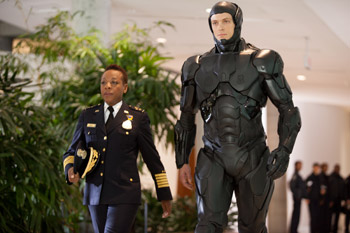
RoboCop has two main weapons: a high-powered Taser that comes out of his thigh (again, a nod to the original film) and a gun that deploys from his forearm. Whist says that it was important to him to maintain a certain level of verisimilitude, even though he was obviously working in the realm of science fiction. 'When we designed the Taser, I wanted it to truly make sense how it would come out, how it would deploy, how it would fit, and how that would translate to a real gun in his hand. We wanted it to seem real, to have a logic to it. It had to be a certain size – after all, it had to fit in the leg. And then we had to figure out how it would deploy in a cool way that he could grab onto."
In designing a futuristic Taser, Whist wanted a design that would not involve a cord. 'The Taser gun fires pellets, little flat discs. When you fire, the discs extend like a camping cup, and little fins come out as it propels through the air. When the pellet strikes something, it recompresses, and that compression pushes out a spike. The whole thing is an advanced battery that gives the victim a shock. It was a lot of fun figuring out the mechanics of how it would work."
RoboCop's other main weapon is a more traditional pistol that comes out of his forearm. 'His arm plate flips open into a gun – it has a brace that goes onto his forearm, near his elbow, and then the gun goes into his hand – the idea is that when the gun recoils, it wasn't putting all that pressure on his wrist. When I design things like that, I like to be as practical as possible, even though what I'm designing is far from practical. I want it to fit into the world – even though a high-powered Taser gun that pops out of a robot's leg is a crazy idea, it should have some logic to it."
Whist also designed the two robots in the film – the ED-209 and the EM-208. 'For the 209, we again made a nod to the original," Whist explains. 'We kept it similar in that it's bipedal, has a big head, and has heavy artillery on it. Still, we wanted to update everything – so we made it more advanced and agile, more dexterous, with heavier guns and more range."
The EM-208 is a new robot for this film. 'If the 209 is like a tank – they blast ahead or clean up afterwards – the 208 was meant to be lighter and quicker," he explains. 'I called them foot soldiers. They can go in and get into smaller places."
In designing these robots, Whist coordinated closely with the visual effects team. 'I designed the 209 as a static image," he explains. 'Once they started animating it and making it move, we had to modify the design. Even though it's a visual effect, there are still real-world physics that have to take place to make it appear to move properly; for example, a joint on a leg would have to be at a certain point so he could lift his leg or swivel a gun."
Whist also designed the vehicles in the film. In one more nod to the original, the police cars are based on the new model of Ford Taurus – just as the first-generation Taurus had taken a starring role in the original film. 'Luckily, the latest model of the Taurus had a cool look to it!" Whist says. 'I was really happy with the police cars, they came out great."
Whist took a decidedly different turn for RoboCop's motorcycle. Based on a Kawasaki 1000, the design team made major modifications. 'We modified the frame, extending the wheel base. It's quite a bit longer than a normal bike, because I wanted RoboCop to take a leaning forward attack position when he's on the bike. He's quite big, and the normal bike looked too small under him. Then, we reclad the whole bike in armor, similar to the suit. He merges with the bike when he's riding it – it looks like one unit. And finally, we redid all the lights and graphics, of course."
Of course, Whist was also responsible for the sets – including Dr. Norton's lab. 'I wanted to keep that set very sterile, rectilinear," says Whist. 'We had a subtext reference of Francis Bacon, who was concerned with the man and the psyche trapped within the constructs of society; in Sellars' office, he has a triptych of Bacons behind him. That's a very strong metaphor for the RoboCop story, so it was also our starting point – and with the design of the lab, it was almost square, 90 degree angles, extremely sterile, glossy reflective white, everything. The walls have cupboards that pull out and the mechanics are integrated into the walls and floors. There are contact points for hoses and machinery integrated into the walls, ceiling, and floor. And then in the middle – and as a stark contrast – is a very organic, curvilinear, mounting bed for RoboCop himself. That's where he uploads and downloads, cycles blood – it's his docking station."
About The Visual Effects
For the film's visual effects, the filmmakers turned to visual effects supervisor James E. Price, who says that the scope of work on RoboCop fell into three main categories: 1) the robots – chiefly the EM-208s, the ED-209s, and RoboCop himself; 2) futurization of the environment; and 3) graphics and displays, including RoboCop's point of view.
The design of the robots began in the art department, but the artists soon began a close collaboration with the visual effects team that would be animating their designs. 'The goal for the 209 was to make it look as real as possible – like it was a real, heavy, menacing robot," says James Price. 'The design is very unique, with a backwards knee and a very large mass to its head, so the challenge was to give it an interesting, mechanical performance that felt like it didn't defy physics – that it could balance and walk appropriately and be menacing without looking awkward."
For the 208s – Whist's 'foot soldiers" – James Price says that the challenges took on a different dimension. 'The 208s have a humanoid design, so we wanted them to have a way of moving that reflected their humanoid joints. But they couldn't be too human; there had to be a mechanical quality to the way that they walked and moved. For us, that was about precision and speed. When a person points from one direction to another very rapidly, their finger and hand might move around a little bit at the end of that move – they are compensating for the mass of their arm as they swing it around. But a robot doesn't have that issue – it has a very finite control over the way it moves its joints. We started by doing motion capture of humans and removing more and more of the overshoot, the bobble and the drift that you saw in the human performance."
For RoboCop himself, all of these aspects and more came into play. 'There were a whole spectrum of techniques we used to bring RoboCop to life," Price continues. 'We started with a performer in a suit – either Joel Kinnaman or a stuntman. In some cases, we replaced portions of the suit – we'd keep only Joel Kinnaman's head and face and replace the rest of the body for a very complex move. And if RoboCop had to complete an action that a human couldn't perform – moving faster or jumping farther – we went to an all-digital version of RoboCop. When we animated RoboCop in those situations, we based the animation on how Joel Kinnaman would move and then we added that extra power or maneuverability or flexibility that only a robot could do."
When it came to futurisation, it was important to take a subtle approach and a gentle hand. 'If you look out the window, you see cars that are one year old and twenty years old and everything in between. Same thing with buildings – in fact, you'll see buildings that are 50 or 100 years old," James Price notes. 'So we didn't want to beat the audience over the head – we wanted to create a subtle evolution of where we are today."
The team's chief challenge in futurization was to change the Detroit skyline. 'We added the very prominent OmniCorp headquarters," James Price notes. 'The top half of the building, the skyscraper, was designed by the art department; the bottom half was modeled on the Vancouver Convention Center, which was where we shot a portion of our finale. For the skyscraper, I went to Detroit and shot aerial background plates of the current Detroit skyline. We had picked a spot in Detroit where the building would be – just south of the Renaissance Center, the classic building with the GM logo on it. There's a park and a plaza area just south of there that was wide open. So we got in a helicopter and hovered in place at that location and we shot a series of stills, making a panorama. We used the gyro stabilized camera and shot a 360-degree view of Detroit from two slightly different altitudes – one that would represent Sellars' office, and another slightly higher that would be the roof, where the helipad is. In post, we used those static frames to create one big, moving panorama."
As a result, the view of Detroit seen from Sellars' windows and from the roof is exactly what one would see if there really were a building on that spot.
The final elements were the graphics and displays – a key part of how RoboCop's point of view would be conveyed to the audience. 'There's a lot of information there – about RoboCop's status, how he monitors his environment, how he assesses things."
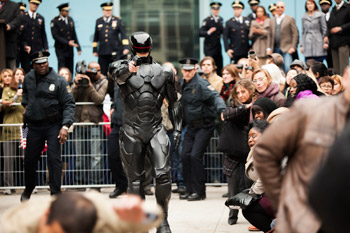 Pulling that off began with the way the filmmakers shot RoboCop's point of view. 'We had a special camera rig that the camera department nicknamed Robo-vision. It was a clever rig – it was a stabilised head mounted on a Steadicam. It enabled you to get a very fluid, Steadicam walking move – something the audience would traditionally associate with a POV shot – but with the remote-controlled head, it got the kind of very precise panning and tilting that we wanted, to add that robotic feel. When you're looking through RoboCop's eyes, you're walking similarly to the way a human would walk, but your attention is able to focus on something and then whip very quickly and precisely over to something else. On top of that, we added a lot of graphics, text, and readouts that would show RoboCop's analysis of what he was looking at."
Pulling that off began with the way the filmmakers shot RoboCop's point of view. 'We had a special camera rig that the camera department nicknamed Robo-vision. It was a clever rig – it was a stabilised head mounted on a Steadicam. It enabled you to get a very fluid, Steadicam walking move – something the audience would traditionally associate with a POV shot – but with the remote-controlled head, it got the kind of very precise panning and tilting that we wanted, to add that robotic feel. When you're looking through RoboCop's eyes, you're walking similarly to the way a human would walk, but your attention is able to focus on something and then whip very quickly and precisely over to something else. On top of that, we added a lot of graphics, text, and readouts that would show RoboCop's analysis of what he was looking at."
Price and his team also created the virtual set for the political commentary show, hosted by Pat Novak – played by Samuel L. Jackson. 'We shot Samuel L Jackson in a 240-degree green screen; his background is entirely animated," says James Price. 'Those scenes had to have their own unique look, so we worked with a company in Los Angeles to design that show package and the look of his sets. Fortunately, Sam has a lot of experience working in that kind of environment, so he knew exactly what to expect."
RoboCop
Release Date: February 6th, 2014
MORE





